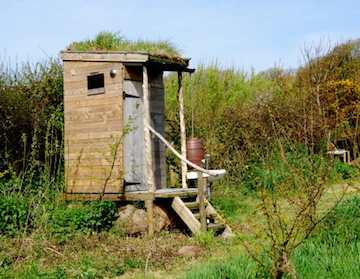
Modern composting toilets – also called waterless toilets – originated in Sweden in 1939. Engineer Rikard Lindstrom was looking for a toilet that wouldn’t pollute the Baltic Sea near his home in Sweden. He launched Clivus Multrum in 1962, and the company and others like it would eventually spread to the United States in the early 1970s. Today, composting toilets are used in a variety of home situations.
Composting toilets are even being encouraged or mandated in resort areas such as Chesapeake Bay and Lake Tahoe to prevent septic tank runoff into natural water systems. There are many misconceptions about composting toilets, says Biolet’s Mike Bowler says. Do composting toilets smell? Aren’t they basically outhouses? Let’s start with the basics. “Composting toilets are a natural process of organic decomposition and liquid evaporation. That’s a simple description of how they work,” Bowler says. “There are different kinds of toilets that go about that in different ways.”
In essence, these toilets work by using a bacteria found in human waste in the composting process. “Below 64 degrees Fahrenheit these bacteria are dormant,” Bowler says. That means most composting toilets either require warm indoor temperatures to work or an onboard heater. The good news, according to Bowler, is that if a composting toilet in a lakeside cabin or summer cottage freezes, it won’t hurt the toilet.
There are electric and nonelectric composting toilets. Electric units often house features such as fans, heaters and mixers to help the composting process, while nonelectric versions tend to be much more basic – although some have small fans powered by solar or battery power.
There are self-contained toilets that have the composting bin inside the toilet, and there are toilets with remote composting bins that fit under cabin floors in the crawl space. Unfortunately, that means cabin owners and renters may have to climb into the crawl space to empty the toilets. But what about the smell? “If you put your nose right down there, yes, it’s going to smell,” Bowler says. “But it won’t smell in the room.” That’s because most composting toilets are vented to the outdoors. “All the companies that make composting toilets work on the concept of a negative air flow. In other words, they have a negative air flow into the toilet,” Bowler says. “Air is flowing from the room into the toilet and out the vent stack.”
A good, solidly constructed vent stack must be properly installed and should be fairly straight without any 90-degree angles to ensure proper air flow. In addition, vents must be properly insulated if they go through any unheated spaces to keep the air rising, Bowler says. Likewise, nonelectric composting toilets typically come with a drain and a drainage pipe. “Nonelectric units, because there are no onboard heaters and sometimes just a small fan to boost evaporation of liquids, come with a drain fitting on them,” Bowler says. “There’s a drain tube that comes with the toilet, and usually that’s run to a French drain, a leach field or some container that you can empty as needed.” But what should be done with the actual compost? The state Department of Health and Human Services and in some cases individual counties and cities have rules about the use of composting toilets and where human waste can be dumped. In Arkansas only pre-manufactured composting or incinerating toilets approved by the Health Department are allowed.
Incinerating toilets, which can be powered by electricity or natural or propane gas, burn the waste. Health department regulations do not require any special form of disposal for the resulting ash. Bowler urges buyers to contact the state department of health and local governments before installing a composting toilet. “We never recommend that you put [the waste] on a vegetable garden,” he says. “What we do know and what I recommend is that if you dig a hole and you put it in the ground and leave it in the ground for at least two years, it’s completely safe.”
4 Responses
Another interesting site is http://www.offgridsteve.co.uk
Great tree bog and cracking little stove !
And other wonderful things
Sorry Alex your right its a
” TREE BOG ”
Not a ” log bog”
Logs on the brain for some reason ?
The ” Tree Bogs ” one of the many wonders of Ecovallee hand crafted by Alex, and what a nice guy he is to !
Thanks for the free publicity, Arch. My compost toilet’s a “tree bog”, to replace a bucket compost toilet I was getting fed up of emptying. I couldn’t find any plans for one, so started from scratch. There are links to other tree bog photos and a video on the blog (https://thedevolutionary.wordpress.com/). And step-by-step photos of the one I made. It did get a bit smelly in the first couple of weeks of use and there may be a couple of reasons for that. I’ll probably add a urine separater before next year which should sort it out.
Hi guys check out Alex Crowes log bog in ecovallee.com
It’s a thing of beauty !
And if you book one of his wonderful offers this winter you get to use it for real !
Hes in the Dordogne France bags of cheap flights
Check it out for a cool off-grid holiday X